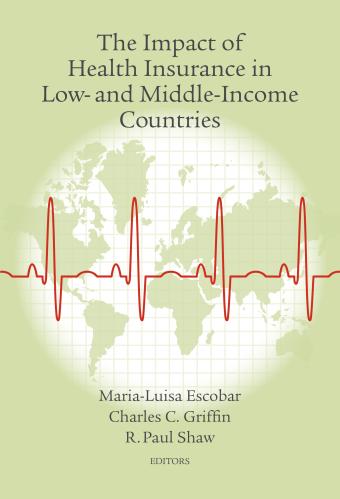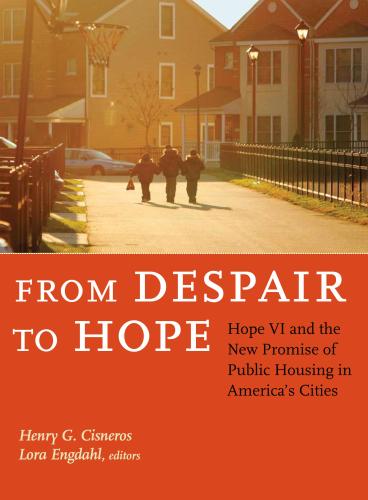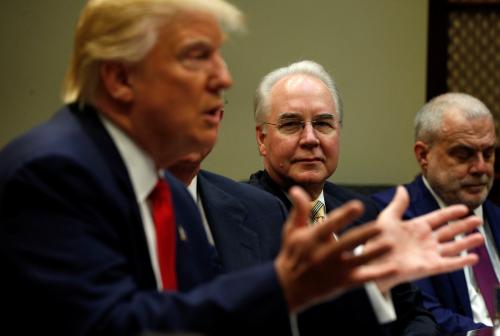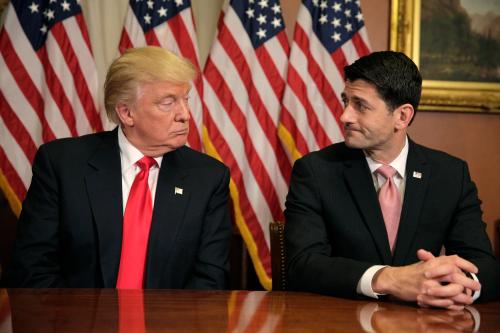This piece originally appeared in The Hill on March 10, 2017.
President Trump has promised a health plan that would provide more coverage at lower cost than ObamaCare does. Now, the Republican Congress has come forward with a plan that would do just the reverse — provide less coverage while increasing costs for low- and moderate-income families. If Congress sends such a bill to Trump and he remains true to his populist rhetoric, he will have to veto it.
The Affordable Care Act (ACA), also known as ObamaCare, has come in for a lot of criticism. Most has been bogus. The ACA has expanded and deepened coverage and lowered out-of-pocket costs. It has brought affordable care within reach for millions who were previously denied coverage or charged exorbitant premiums.
But some of the criticism is valid. Even with financial assistance, some people face premiums they find hard to afford. In counties, particularly sparsely populated counties, they have little choice among competing insurance plans. The solution to these problems is to make insurance more affordable for more people so that insurers find it worthwhile to offer coverage everywhere.
The way to do that is to provide somewhat more generous assistance to people with low to moderate incomes than ObamaCare provides. Doing so would have at least three benefits. It would boost coverage, reduce resistance to the rule requiring people to carry health insurance, and increase the number of potential customers for insurers.
The Republican plan, released this week, would, if enacted, do none of these things. It would cut off Medicaid coverage altogether to millions of low-income households. It would encourage states to cut Medicaid benefits for those who remain covered by eliminating federal cost sharing on additional outlays. It would reduce financial help to the old and the sick — those who have most difficulty affording health insurance. Meanwhile, it would extend subsidies to higher-income households, who need little or no help in affording insurance coverage.
Overall, the plan would boost the number of uninsured and shift federal assistance away from some of the most vulnerable people in this nation, while cutting taxes for the richest.
To recognize what is being proposed, consider how ObamaCare helps bring health coverage to people with low or moderate incomes. For the poor and near-poor, it provides expanded access to Medicaid. For people not covered by a federal program or affordable employment-based coverage, it provides refundable tax credits to help with the purchase of private insurance. Those credits are available to people with income up to four times the federal poverty threshold — about $65,000 for a couple and $96,000 for a family of four.
In addition, ObamaCare provides those whose incomes are below more modest thresholds — $41,000 for couples and $61,000 for families of four — with assistance in paying deductibles and copayments. It requires insurers to sell coverage to anyone who wants it and bars insurers from jacking up prices to those with preexisting conditions. So that people won’t wait until they are sick to buy coverage, the law requires people to show that they have insurance or to pay a tax penalty.
The Republican plan would reverse direction in more ways than one. It proposes to curtail federal funding that states have used to newly cover approximately 12 million people through Medicaid. It would change the structure of federal support of the Medicaid so that states could cut benefits without any financial penalty. They would lose $1 to nearly $4 of federal money for each $1 of state money they save by cutting benefits.
The Republican plan would eliminate assistance with deductibles and copayments for low-income households. It would reduce the refundable tax credits ObamaCare provides to available to comparatively old and poor households to help them afford health insurance premiums. In contrast, the plan would increase credits available to most comparatively young and middle-income households. In addition, It would extend full assistance to higher income households most of whom can afford health insurance without assistance — by providing tax credits of as much as $8,000 to couples with incomes as high as $150,000 a year, two-and-one-half times the current limits under ObamaCare.
The Republican plan would also repeal a series of taxes that fall exclusively on high-earners and the wealthy. One of those taxes helps support Medicare. Its repeal would hasten depletion of the Hospital Insurance Trust Fund.
Overall, the plan would boost the number of uninsured and shift federal assistance away from some of the most vulnerable people in this nation, while cutting taxes for the richest. Exact estimates of each of these effects must await official reports from the Congressional Budget Office and other research organizations.
Democrats have often charged that Republican policies favor the financially secure. Republicans have often responded by accusing Democrats of engaging in “class warfare.” The Republican health proposal released this week supports the charges Democrats have made. If class warfare is being waged, it is not Democrats who are the aggressors.
The Brookings Institution is committed to quality, independence, and impact.
We are supported by a diverse array of funders. In line with our values and policies, each Brookings publication represents the sole views of its author(s).










Commentary
Op-edRepublicans are flirting with class warfare in their health care bill
March 13, 2017